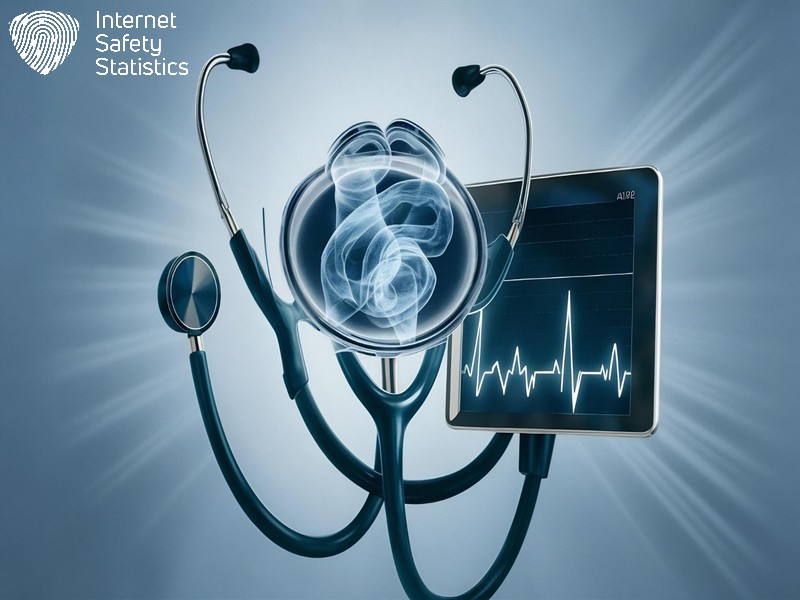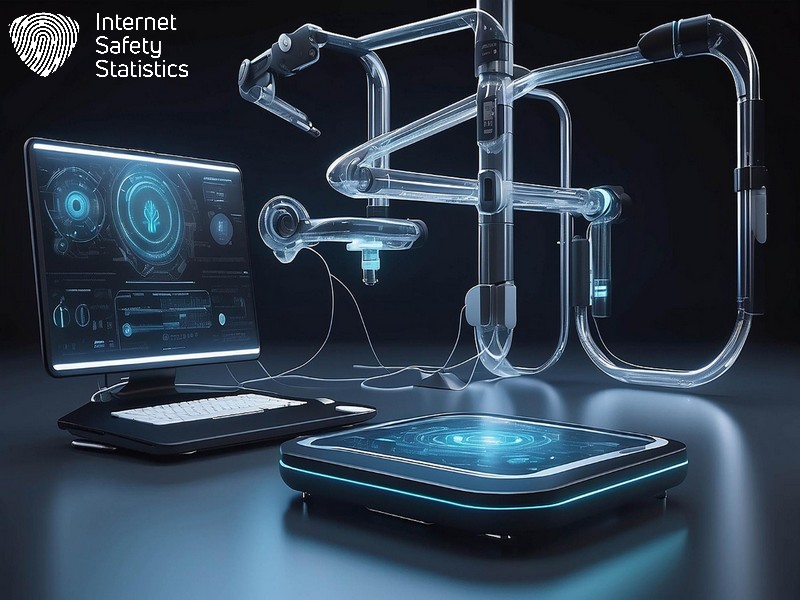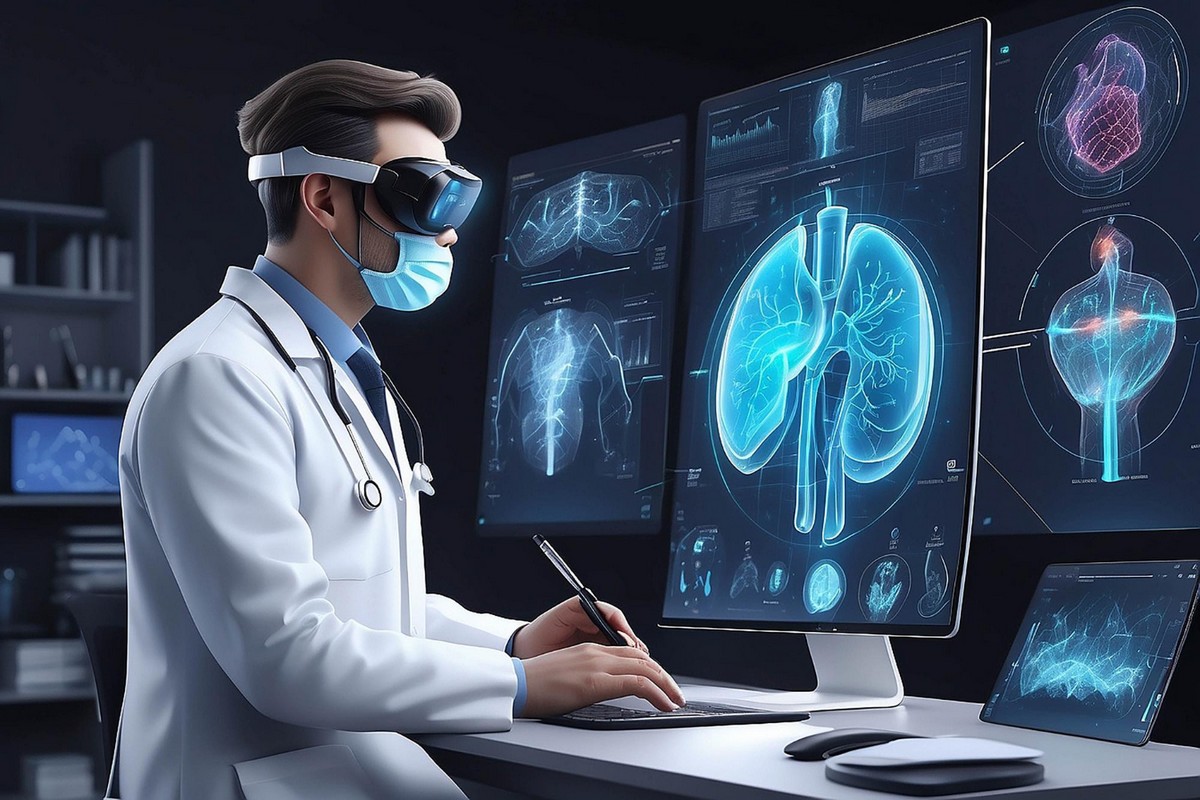
The Internet of Things (IoT) has transformed how we interact with the world around us. This connectivity revolution is now reaching the healthcare sector with the rise of the Internet of Medical Things (IoMT). IoMT devices, from implantable cardiac monitors to smart inhalers, collect real-time patient data, offering significant potential for improved diagnosis, treatment, and remote monitoring.
However, the interconnected nature of IoMT presents a unique challenge: security. These devices collect and transmit sensitive medical information, making them a prime target for cyberattacks. A data breach involving IoMT devices could compromise patient privacy, disrupt critical healthcare services, and potentially endanger patient lives.
This guide delves into evolving from IoT to IoMT security. We will explore the specific vulnerabilities associated with these medical devices and the potential consequences of cyberattacks. The discussion will then shift towards practical strategies for safeguarding patient data and ensuring the secure operation of IoMT devices within healthcare facilities. By prioritising robust security measures, we can unlock the full potential of IoMT while mitigating the risks to patient privacy and well-being.
This article will explore how to protect these innovative devices and the sensitive data they handle. Stay informed and keep your health data secure!
Overview of IoMT and its Importance for Healthcare
The Internet of Medical Things (IoMT) is revolutionising the healthcare industry by connecting medical devices and enabling remote monitoring, improving patient care. This advancement in health technology has the potential to streamline processes, increase efficiency, and ultimately save lives.
The Rise of the Internet of Medical Things
Hospitals and clinics are now transitioning from IoT to IoMT devices at an unprecedented rate, ushering in a new era in healthcare. These smart gadgets range from wearable technology that monitors heart rates and blood sugar levels to advanced medical implants that report patient health indicators directly to doctors. Seamlessly connecting through the healthcare network enables real-time data sharing and remote patient monitoring.
This high-tech revolution means more than just convenience; it is changing lives by making healthcare accessible even when patients are miles away from their doctors. IoMT allows for immediate updates on patient conditions, which can be life-saving in emergencies or chronic disease management.
As these technologies advance, they promise a future where health assessments happen anywhere you have internet access – shifting the focus of medicine towards prevention rather than treatment after the fact.
Benefits and Advancements in Healthcare
The rise of IoMT has brought significant benefits and advancements to healthcare. With the help of connected medical devices and remote monitoring systems, patients can receive more efficient and personalised care.
Healthcare providers also benefit from real-time data analytics, allowing them to make informed decisions and provide proactive interventions. The impact of IoMT includes improved patient outcomes, reduced hospital readmissions, and better management of chronic conditions, ultimately leading to enhanced quality of care for all individuals seeking medical treatment.
Furthermore, IoMT allows a shift towards preventive care through continuous monitoring and early intervention based on data-driven insights. This improves patient experience and reduces healthcare costs by preventing complications or emergencies.
Integrating automation, sensors, and machine-based intelligence in smart healthcare is revolutionising the industry by streamlining processes and reducing human error while ensuring patient data security throughout the entire continuum of care.
Security and Privacy Concerns in IoMT Devices

IoMT devices are susceptible to vulnerabilities and threats, leading to potential hospital cyberattacks. These attacks can compromise patient data and pose risks to healthcare providers and their patients.
Vulnerabilities and Threats
Cybersecurity threats pose risks to IoMT devices and patient data, making it a top concern in the healthcare industry. Attackers target vulnerabilities in IoMT systems, exploiting weak security measures to access sensitive medical information. Hospitals have experienced cyberattacks leading to compromised patient data and disrupted health services due to these vulnerabilities and threats.
Patient data protection must be prioritised as IoT devices connect wirelessly within the healthcare network, transmitting vital information across the connected infrastructure. As healthcare providers leverage remote monitoring and data-driven insights with IoMT, addressing these security concerns becomes critical for safeguarding sensitive medical information from potential cyber threats.
Examples of Cyberattacks on Hospitals
Cybercriminals have targeted hospitals with various cyberattacks, compromising patient data and disrupting critical healthcare services. In these attacks, malicious actors exploit vulnerabilities in medical devices and healthcare systems to gain unauthorised access. Here are examples of cyberattacks on hospitals:
- Malware Infiltration: Malicious software infiltrates hospital networks through vulnerable medical devices, causing system outages and compromising patient data integrity.
- Ransomware Incidents: Hospitals have fallen victim to ransomware attacks where cybercriminals encrypt vital healthcare data, demanding hefty ransoms for decryption keys.
- Phishing Scams: Cybercriminals use deceptive emails and fake websites to trick hospital staff into divulging sensitive information or granting unauthorised access to crucial systems.
- Data Breaches: Personal health records and sensitive patient information have been exposed in data breaches due to inadequate security measures within hospital networks.
- Insider Threats: Instances of insider threats within hospitals involve employees misusing their access privileges to compromise patient data or disrupt hospital operations.
- Denial-of-Service Attacks: Hospitals have experienced disruptive distributed denial-of-service attacks that render essential medical services inaccessible to needy patients.
Securing IoMT Devices: Best Practices for Hospitals
Hospitals can secure IoMT devices by identifying and classifying cyber threats, leveraging advanced automation, and utilising data analytics for security monitoring. These best practices are crucial in ensuring the safety and privacy of patient data in a connected healthcare environment.
Identifying and Classifying Cyber Threats
Each hospital or healthcare facility should have a skilled IT team that will identify possible cyber threats that will strike the facility. This vital step includes implementing rigorous cybersecurity measures and intrusion detection systems.
- Implement robust intrusion detection systems to identify unauthorised access attempts or suspicious activities.
- Utilise network segmentation to classify cyber threats based on their impact and potential risks.
- Employ advanced threat intelligence tools to identify and categorise emerging cyber threats proactively.
- Regular vulnerability assessments should be conducted to identify weaknesses in IoMT devices and address them promptly.
- Leverage machine learning algorithms to classify and prioritise potential cyber threats based on historical data and patterns.
- Establish incident response plans to classify and respond to different categories of cyber threats swiftly.
Leveraging Advanced Automation
Hospitals can enhance IoMT security by leveraging advanced automation. Automated systems can identify potential cyber threats in real-time, allowing immediate response and mitigation.
By utilising automated processes, hospitals can continuously monitor the network for any abnormal activities and quickly address security concerns before they escalate.
Automation also streamlines security measures, saving time and resources while ensuring a proactive approach to protecting medical devices and patient data. With automation, hospitals can avoid evolving cyber threats and maintain a secure IoMT environment that prioritises patient privacy and data integrity.
Utilising Data Analytics for Security Monitoring
To complement advanced automation, utilising data analytics for security monitoring is crucial in safeguarding IoMT devices and patient data. Hospitals can detect abnormal patterns that may indicate potential threats or breaches by analysing vast network traffic, system logs and user activities.
Data analytics help healthcare facilities proactively identify vulnerabilities and continuously monitor their systems for suspicious activities or unauthorised access attempts.
This allows them to respond promptly to security incidents, mitigating risks and ensuring patient data integrity in IoMT devices. Additionally, by leveraging machine learning algorithms and predictive analysis, hospitals can stay ahead of evolving cyber threats and adapt their security measures accordingly.
Challenges and Solutions for IoMT Security
Challenges in IoMT security include the long lifecycle of devices and lack of standardisation. Still, solutions such as a zero-trust approach, lightweight authentication protocols, and regular updates can help mitigate these challenges.
Long Lifecycle of Devices
IoMT devices have a long lifecycle, meaning they remain used for extended periods. This leads to challenges in maintaining security and keeping up with evolving threats. With the rapid pace of technological advancements, ensuring ongoing security updates and support for older IoMT devices becomes increasingly complex.
Medical regulations often require these devices to adhere to the same level of security throughout their lifespan, making implementing robust security measures crucial.
As new vulnerabilities emerge, hospitals must proactively address risks associated with ageing IoMT devices while also considering factors such as data integrity and patient privacy throughout their extended lifecycle.
Lack of Standardisation
IoMT devices operate under different standards and protocols, leading to a lack of standardisation across the healthcare industry. This absence of uniformity makes it challenging for hospitals to implement consistent security measures and protocols for protecting patient data.
The variability in device specifications also complicates efforts to ensure that all IoMT devices adhere to essential cybersecurity standards, leaving potential vulnerabilities that cybercriminals could exploit.
Moreover, the absence of standardisation complicates updates and patches for security flaws identified in IoMT devices. Hospitals face difficulties ensuring that all devices are promptly updated with security patches and software upgrades without standardised processes. As a result, this inconsistency poses significant challenges for maintaining comprehensive cybersecurity across diverse IoMT infrastructure.
Insufficiency of Traditional Security Measures
Traditional security measures are insufficient to address the evolving threats IoMT devices face. These devices have longer lifecycles, making it challenging for traditional security protocols to keep up with ongoing updates and patches.
Additionally, the lack of standardisation in device communication and authentication methods further exacerbates the insufficiency of traditional security measures within healthcare environments.
Furthermore, as cyberattacks on hospitals and medical facilities become increasingly sophisticated, adopting modern approaches prioritising continuous monitoring and robust encryption techniques is crucial.
Unlocking Effective IoMT Security with BitLyft

BitLyft offers a zero-trust approach, biometric-based authentication, and lightweight authentication protocols to ensure the security of IoMT devices. Read the blog post on how BitLyft can help secure medical devices and patient data.
Zero-trust Approach
A zero-trust approach is essential for securing IoMT devices and patient data. With this strategy, every user and device accessing the network must be verified and authenticated before being granted access, regardless of location or previous access privileges.
By continuously validating identities and monitoring device behaviour, hospitals can reduce the risk of unauthorised access and potential breaches, providing an additional layer of security in an increasingly interconnected healthcare environment.
The zero-trust approach ensures that all connections to medical devices are consistently validated, making it more difficult for cyber attackers to exploit system vulnerabilities.
Privacy Mechanisms
Implementing effective privacy mechanisms is crucial to safeguard patient data in IoMT devices. Encryption plays a vital role in protecting the confidentiality and integrity of sensitive healthcare information.
Using lightweight authentication protocols and biometric-based authentication, hospitals can ensure that only authorised individuals can access patient data, minimising the risk of unauthorised breaches.
Regular updates and risk assessments are essential to maintaining robust privacy measures and keeping IoMT devices secure against evolving cyber threats.
Lightweight Authentication Protocols
IoMT devices need robust security measures to protect sensitive patient data and prevent unauthorised access. Lightweight authentication protocols play a crucial role in ensuring the integrity of IoMT networks.
These protocols provide efficient ways to verify user identities without compromising performance or adding excessive overhead. By implementing lightweight authentication protocols, healthcare organisations can securely manage access to medical devices and patient data, safeguarding against potential cyber threats and unauthorised use.
With streamlined processes for verifying identities, hospitals can enhance the overall security posture of their IoMT infrastructure.
Biometric-based Authentication
Biometric-based authentication provides a highly secure method for ensuring only authorised personnel access sensitive medical device data. This technology uses unique biological traits such as fingerprints, facial recognition, or iris scans to identify individuals accurately and with high certainty.
By incorporating biometric authentication into IoMT devices, hospitals can significantly bolster their security measures and protect patient data from unauthorised access.
Implementing biometric-based authentication in IoMT devices aligns with the healthcare industry’s stringent regulatory requirements. With the need to safeguard patient privacy and ensure secure access to medical records, this advanced authentication method offers a robust solution beyond traditional password-based systems.
Role of Encryption
Encryption plays a crucial role in securing IoMT devices and patient data. It involves converting sensitive information into a code to prevent unauthorised access and ensure that only authorised parties can understand the data.
This security measure helps protect medical records, health information, and communication between devices from cyber threats. Encryption also enables secure data transmission over the cloud, safeguarding it from interception or tampering.
Implementing strong encryption protocols is essential for maintaining the confidentiality and integrity of healthcare data within IoMT networks. By using robust encryption techniques, healthcare providers can ensure that patient privacy is upheld while maintaining patients’ trust and confidence in the security of their medical information.
Importance of Regular Updates and Risk Assessments

Regular updates and risk assessments are significant to any software or gadget’s success. Without these elements, the door to application vulnerabilities is unguarded against prying eyes and cyber attackers. Going from IoT to IoMT increases the importance of other elements, such as compliance monitoring and device performance optimisation, because IoMTs deal with human life’s most valuable asset.
Regular Updates
Regularly updating relevant IoMTs ensures flawless functionality and helps maintain and save lives.
- Updates address vulnerabilities and patch security flaws in IoMT devices.
- They enhance the overall security posture by incorporating the latest security features.
Risk Assessments
Regular risk assessments address possible vulnerabilities in the devices’ functions or operating systems. They ensure the IoMTs can withstand potential cyberattacks.
- Regular risk assessments identify potential weaknesses and areas for improvement in the IoMT network.
- They enable proactive measures against emerging cyber threats, safeguarding patient information.
Compliance Monitoring
Although IoMTs are closely tied to human life, they must comply with legislative and regulatory laws and regulations.
- Ensuring compliance with industry regulations through regular updates and risk assessments reduces the risk of data breaches.
- It allows healthcare organisations to uphold privacy standards and data protection regulations.
Cyber Threat Intelligence
The previous preventative steps will ensure the medical teams’ ability to predict and counteract possible cyber threats.
- Regular updates and risk assessments provide insights into current cyber threats and trends, enabling informed decision-making on security strategies.
- This proactive approach helps healthcare providers avoid potential patient data risks.
Device Performance Optimisation
Regular updates and risk assessments help oil the working gears of IoMT devices, which will help maintain seamless medical service and ensure proper functionality.
- By conducting regular updates and risk assessments, healthcare facilities can improve the performance of IoMT devices while ensuring robust security measures.
- This optimisation contributes to a seamless healthcare delivery system while prioritising patient data privacy.
Incident Response Preparedness
A solid incident response plan is the backbone of cybersecurity measures. Regular updates and risk assessments allow healthcare providers to prepare contingency plans in a cyberattack.
- Through regular updates and risk assessments, healthcare providers can prepare an effective incident response plan for addressing potential cybersecurity incidents.
- Proactive measures help minimise the impact of any security breaches on patient data integrity.
Securing IoMT devices and patient data is crucial for the advancement of healthcare. Implementing robust security measures, including encryption and regular risk assessments, is vital to protect against cyber threats. Hospitals must embrace advanced automation and leverage data analytics to monitor and mitigate potential vulnerabilities effectively. With the right approach and solutions in place, IoMT can continue to revolutionise healthcare while ensuring the safety and privacy of patient data.
FAQs
What is the Internet of Medical Things (IoMT)?
The IoMT is a network of connected healthcare devices that collect and share patient data to improve medical outcomes and streamline care.
Why is cybersecurity important for medical devices?
Cybersecurity in healthcare ensures that medical device security protects sensitive patient data from unauthorised access and cyber threats.
How does IoMT enhance patient data protection?
By using advanced privacy and security protocols, IoMT safeguards against breaches, keeping personal health information secure on connected healthcare devices.
What should hospitals do to improve the security of their IoT devices?
Hospitals must implement robust cybersecurity measures, regularly update systems, and train staff to secure each Internet-connected device to protect patient data effectively.
